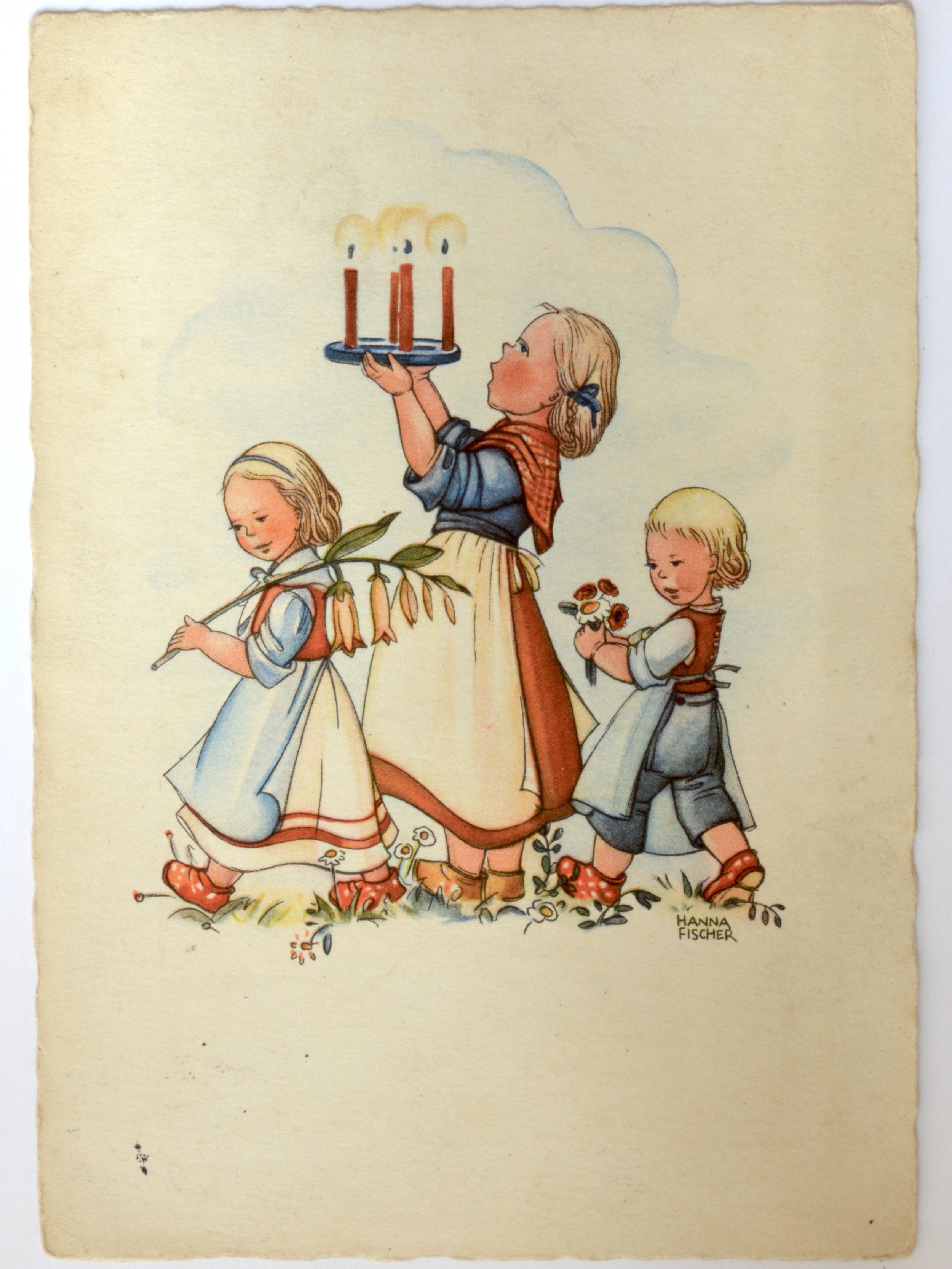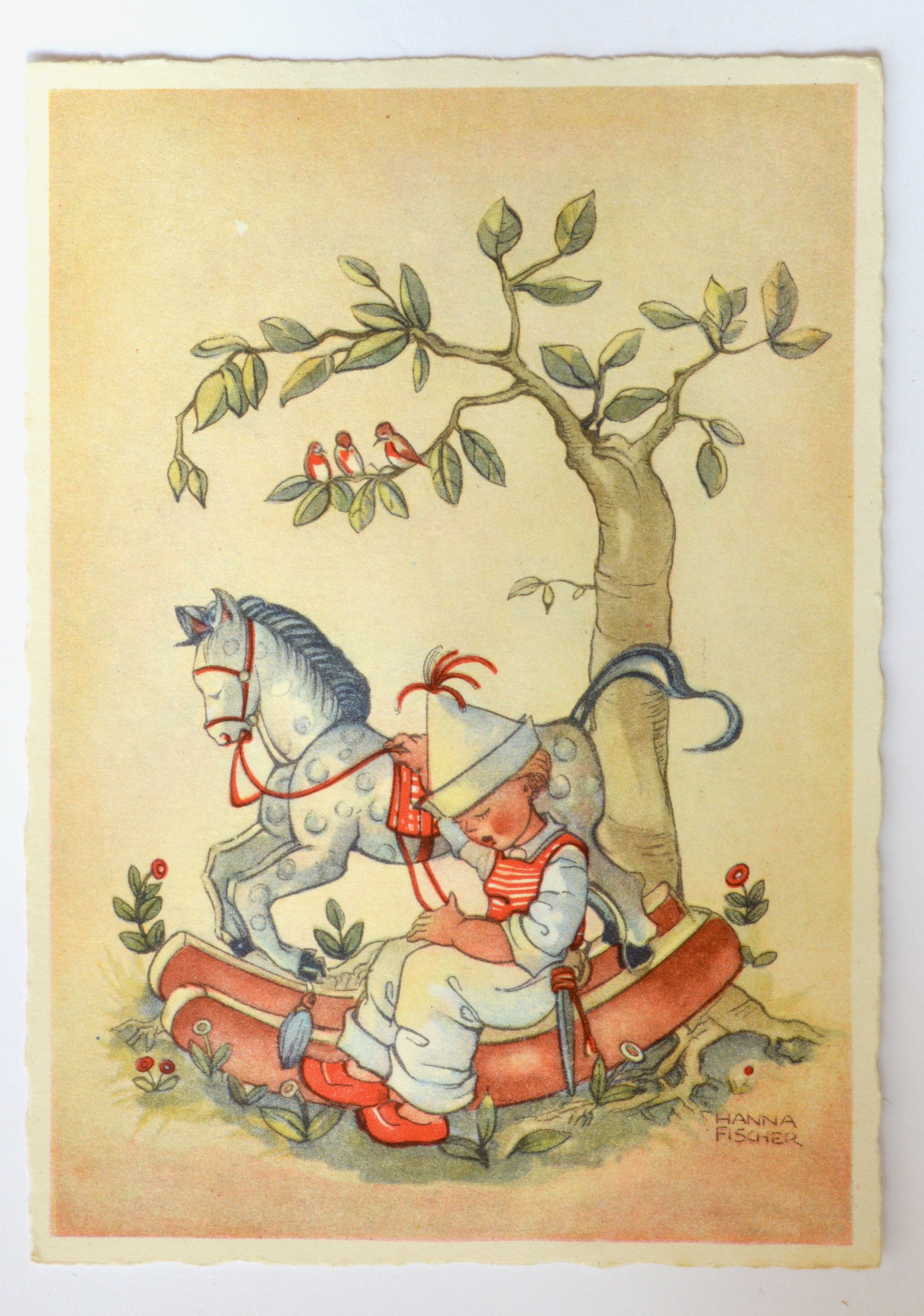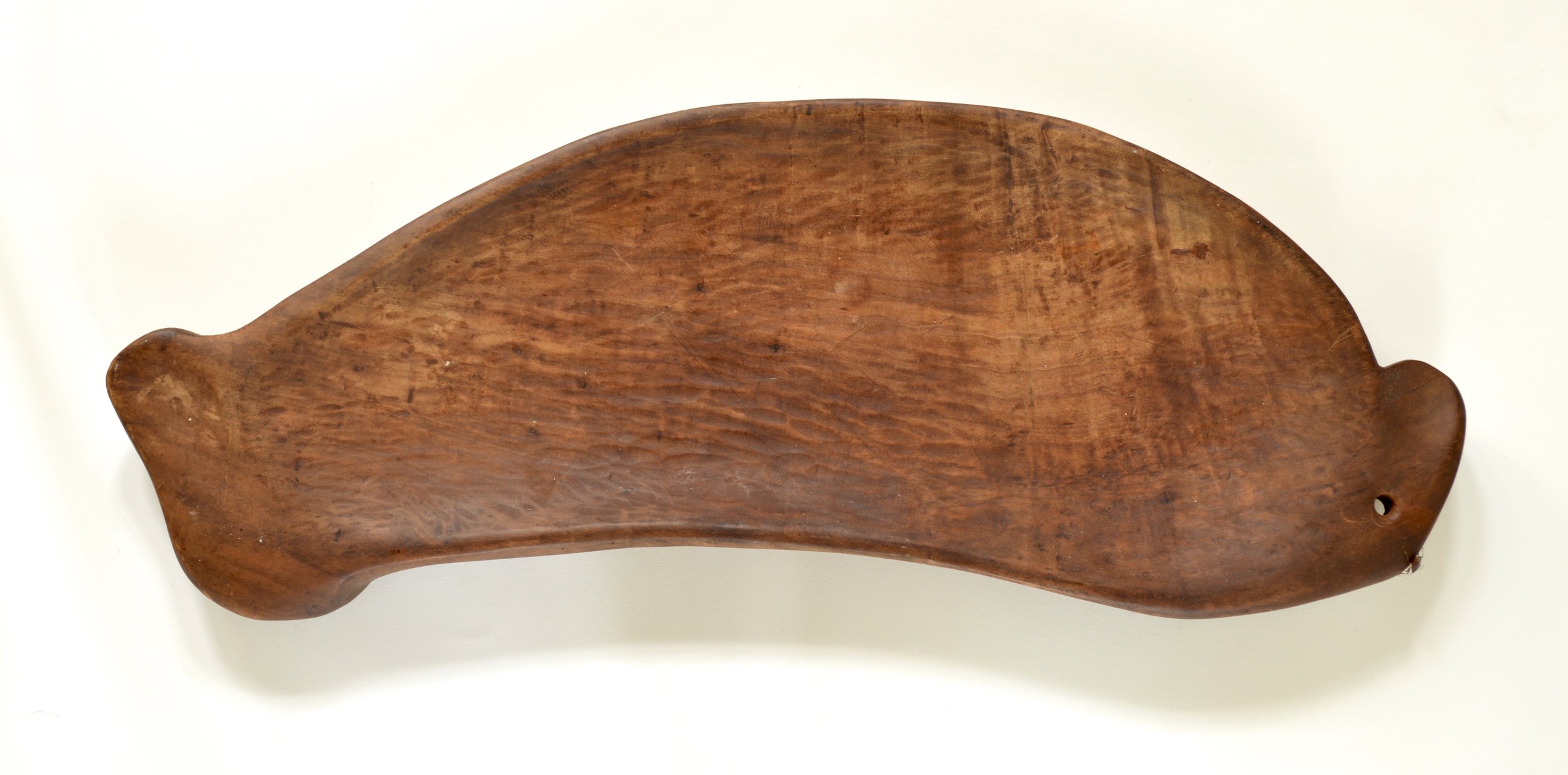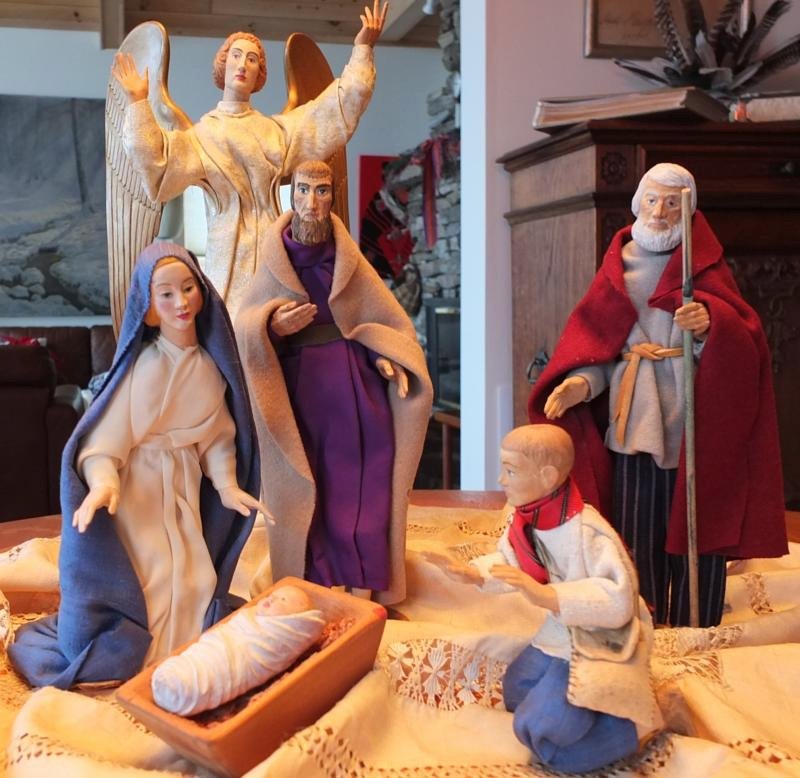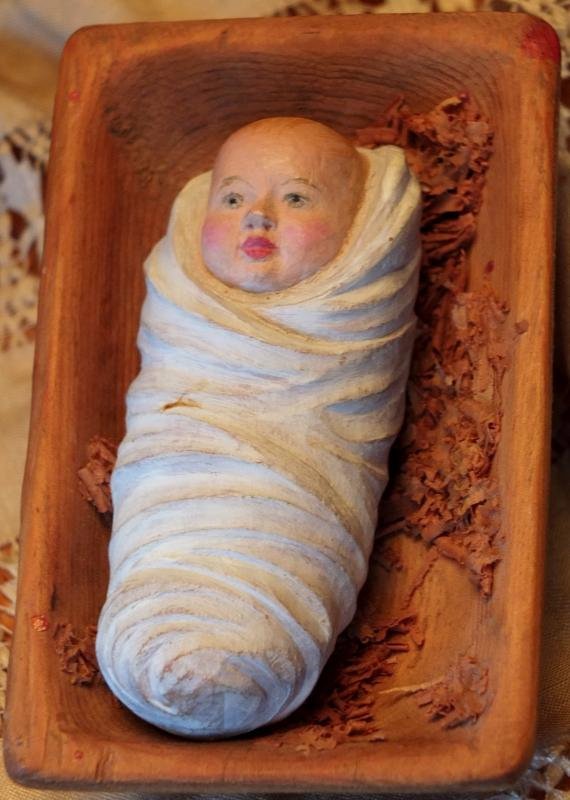Glencairn Museum News | Number 12, 2021
Left: In-the-round ivory sculptural figure, c. 1920s, 8 ¾” tall. Collection of Cord Fischer. Photo © Mark Sfirri. Right: Angel musician. Private collection. Photo © Mark Sfirri.
Figure 1. This small painting (6 ¼” X 5”) was created by Johanna Speckner in 1916 when she was 15 or 16 years old. (Likely a portrait of her and her sister.) Collection of Cord Fischer. Photo © Mark Sfirri.
The world remembers 1929 as the year that the stock market crashed, causing a long decade of global economic devastation. However, for two artists that year presented a happier financial picture, marking the beginning of a patronage which carried them both through the Great Depression. The patron was Helene Koerting Fischer (1879-1970), and the artists were Hanna Weil (1900–1985) of Holzhausen, Bavaria, Germany, and Wharton Esherick (1887–1970) of Paoli, Pennsylvania. While these sales occurred four thousand miles apart, they were the beginning of a close association among the three that affected the lives of the artists profoundly.
Johanna Speckner was born in Munich, Germany. In the interest of clarity, she is referred to by her first name throughout this article (as is everyone else), because she had several last names in the course of her life. She is best known to Glencairn Museum visitors as Hanna Binder, the artist responsible for the Nativity figures that she carved in the 1940s and 50s.
There is evidence that Johanna was interested in art as a girl (Figure 1), and as a young woman she went to art school in Munich, likely the acclaimed Academy of Fine Arts. She studied drawing, marble carving, and jewelry, and apprenticed to both a silversmith and a goldsmith. She taught herself to carve ivory and became quite skilled. She developed a remarkable grasp of the human form that she was able to realize two-dimensionally in her drawings and cut paper designs (Figures 2–3), and three-dimensionally in her bas-relief and in-the-round carvings. She understood and was able to reveal the subtle nuances of the underlying skeletal and muscular forms, as well as the proportions of the body, in a masterful way. She probably studied drawing anatomy, as it was and is a subject that is part of nearly all serious art programs. When drawing or sculpting forms that are abstract or non-objective, there is much more leeway for exaggerating proportions for effect, but when portraying the human form in a realistic way any incorrect dimension or proportion would appear as a glaring mistake. There is none in her work.
Figure 2. Hanna Weil-made cut paper design from 1923–1929 (see also Figure 3). Collection of Cord Fischer. Photo © Mark Sfirri.
Figure 3. Hanna Weil-made cut paper design from 1923–1929 (see also Figure 2). Collection of Cord Fischer. Photo © Mark Sfirri.
In 1922 Johanna married Otto Weil (1884–1929), a painter whose work was informed by Impressionism. She shortened her first name to Hanna and took her husband’s last name. In 1923 the Weils moved to a house in the town of Utting, about thirty miles west of Munich in Holzhausen, Bavaria, which overlooks Lake Ammersee. In 1924, they had a daughter called Hanlo.
The Glaspalast was an enormous glass structure in Munich, patterned after the Crystal Palace in London, and it was a prestigious venue for exhibiting Hanna’s and Otto’s work. Beginning in 1889, the 170,000-square-foot gallery space was used to display an annual, four-month-long, major juried exhibition that contained about 3,000 objects highlighting contemporary German art and craft. Hanna exhibited her work there from 1928 to 1930. She was concentrating on ivory carving then, sometimes combined with silver or gold, her principal focus for over a decade (Figures 4–7). Although more celebrated artists had a number of works included each year, most artists, including Hanna, exhibited only one.
Figure 4. Bas-relief carved ivory panel in a silver case, combining Hanna’s skills as an ivory carver and silversmith, c. 1920s. Whereabouts unknown. Photo from the Fischer family archive.
Figure 5. Carved ivory perfume bottle, c. 1920s. Whereabouts unknown. Photo from Fischer family archive.
Figure 6. Carved ivory figure, c. 1920s. Whereabouts unknown. Photo from Fischer family archive.
Figure 7. Ivory and silver case, 2” × 6” x 4”, c. 1920s. Collection of Peter Fischer Cooke. Photo © Mark Sfirri.
In February of 1929, at the age of 43, Otto Weil died of pneumonia, leaving Hanna, then 29, the sole breadwinner and single parent of their five-year-old child. That summer, Hanna’s entry in the Glaspalast exhibition, representing 1/3000 of the show, was noticed by a German-born, American industrialist named Helene Fischer. Fischer had controlling interest, given to her in 1917 by her father, Dr. Ernst Körting, in a Philadelphia company called Schutte & Koerting. She bought Hanna’s ivory piece in the exhibition and commissioned a necklace (Figure 8). Often, when Helene took interest in artists, she not only bought their work but became a part of their lives, as was the case here.
Figure 8. Ivory necklace. Private collection. Photo © Mark Sfirri.
Germany’s economy, already struggling under the burden of post-WWI reparation payments required by the Treaty of Versailles, quickly felt the effects of the U.S. stock market crash. To help Hanna financially, Helene arranged to have her son, York Fischer (1907–1985), aged 23, study art with Hanna, likely in 1930. Then Helene invited Hanna to come to stay at the Fischers’ house in the West Mount Airy section of Philadelphia, as part of her patronage. This arrangement offered Hanna a level of security and comfort she could not have managed on her own. Hanna, Hanlo, and York arrived in Philadelphia in September 1930.
Meanwhile, Wharton Esherick completed a large studio in 1927 on a hill behind the house he shared with his wife Letty and their three children. In the summer of 1928, he separated from Letty and began living in the studio, while Letty and the children continued to live in the house. In December of 1928, Letty was bitten by a mosquito and contracted encephalitis, which diminished her mentally for the rest of her life. She and Wharton continued to live separately but never divorced.
At this point, Wharton, who would later become known as the founder of the Studio Furniture Movement in the U.S., was just beginning his work in furniture. In 1929, he displayed a sculptural figure titled “Finale” at the Hedgerow Theatre in Rose Valley, Pennsylvania. Helene, a patron of Hedgerow, saw the piece and purchased it. Over the next fifteen years she commissioned him to make numerous major pieces of furniture for her house, and many more pieces for the boardroom of Schutte & Koerting. The first furniture commission was a piece that served as a base for “Finale” as well as a cabinet for the family’s Victrola. Hanna’s introduction to Wharton was through this work, which was placed in the entryway of the Fischer home (Figure 9).
Figure 9. Wharton’s sculpture “Finale,” an abstracted reclining female form, purchased by Helene Fischer in 1929. It sits on the first of many commissions for Fischer, his “Victrola Cabinet,” which served the dual purpose of being a base for “Finale” and a cabinet for their Victrola. Photo from Fischer family archive.
Figure 10. Wharton’s “Corner Desk.” Designed in 1930, completed in early March 1931. Private collection. Photo © Mark Sfirri.
Helene thought that Hanna and Wharton should meet, and arranged a trip to Wharton’s studio on Hanna’s birthday, October 8, 1930. It was the first of many visits that fall and winter, establishing a deep friendship that lasted the rest of their lives. They connected over their shared interests in art in general and in carving, drawing, painting, and printmaking. It was a particularly creative period for both of them. Wharton was beginning work on the design of perhaps the finest piece of furniture of his career, the “Corner Desk” for Helene (Figure 10).
Hanna returned to Germany, likely in March of 1931. For some reason—perhaps it was too late to enter, or she had nothing available—she did not show any work in the Glaspalast exhibition that year. This turned out to be a small blessing. In June of 1931, five days into the exhibition, the building burned to the ground and nearly all the artwork, historical and contemporary, of incalculable value, was destroyed. The Glaspalast was never rebuilt. Its loss was considered a national tragedy.
After Hanna’s departure, Wharton made numerous drawings for her, one of which was captioned, “Hannah, Two Empty Benches at my Studio Door, April 1931” (Figure 11), which suggests that he was missing her. He also carved her an elegant ladle inscribed, “For Hannah to Brew a Stew for Wharton MCMXXXI” (Figures 12–13). Helene generously sponsored a trip for Wharton to visit Hanna for several months that summer. Their time together was full of trips and projects. They traveled to Munich and to Scandinavia to see art (Figures 14–15), while York took care of Hanlo in Holzhausen. After their trip, Wharton remained in Holzhausen with Hanna, Hanlo, and York (Figures 16–17). He designed and, with the help of Hanna and York (Figure 18), built a large worktable with two book-matched boards of pear wood for the top and an oak base (Figure 19). This table was used by Hanna for her ivory carving. She sketched a portrait of Wharton and with minimal lines she was able to capture him in a cartoonlike, yet realistic, way (Figure 20).
Figure 11. “Hannah, Two Empty Benches at My Studio Door, April 1931.” Private collection. Photo © John Carlano.
Figure 12. Inscribed “For Hannah to Brew a Stew for Wharton MCMXXXI” (see also Figure 13). This ladle was a present from Wharton Esherick to Hanna Weil, likely given to her when he visited Germany in the summer of 1931, 17” X 4” X 2 ½”. Private collection. Photo © Mark Sfirri.
Figure 13. Profile view of ladle (see also Figure 12). Photo © Mark Sfirri.
Figure 14. Wharton Esherick and Hanna Weil while traveling together to Scandinavia in the summer of 1931. Private collection.
Figure 15. Wharton Esherick captured moments, not with a camera, but with pencil and paper sketching. Here he is on a canal boat in Sweden. Private collection.
Figure 16. Hanna Weil and Wharton Esherick on the porch of Hanna’s Holzhausen home. Private collection.
Figure 17. York Fischer, whom Hanna would marry in 1932, with Wharton Esherick at Holzhausen in 1931. Private collection.
Figure 18. Hanna and Wharton working together in Holzhausen in the summer of 1931. Private collection.
Figure 19. Designed by Wharton and built with the help of Hanna and York, this work table was made for Hanna’s ivory carving. There is a one-inch hole in the top for her vise for holding the ivory. It is the only piece of Wharton’s furniture built outside of the U.S. Private collection.
Figure 20. Cartoonlike sketch of Wharton Esherick by Hanna Weil, likely from 1931. Private collection. Photo © John Carlano.
Wharton left Germany in September. While there was chemistry between Wharton and Hanna, Wharton’s life was complicated by the fact of his marriage and by his wife’s condition. We cannot know all the reasons that kept them apart. In any case, Hanna married York in April of 1932. They remained in Germany in her house in Holzhausen and they had two children, York (1935– ) and Barbara (1937–2016). In 1936 the family traveled to the U.S. for a reunion at the Fischers’ house (Figure 21). In 1937 Hanna was busy making a dozen or so small ivory carvings of animals and insects for Helene, to be used as place holders for large family gatherings (Figures 22–25). Her understanding of the human form was exceptional, and these pieces show that her understanding of animal forms was just as remarkable. They are further examples of her creativity and technical skill, as is an ivory pill holder (Figure 26), incised on its top with an image of a crab, filled in with black to contrast against the ivory. A much earlier example of her interest in animal forms is evident in the bas-relief carved dog on a plaster mold for a 1919 medallion, which she made while studying metal casting (Figure 27).
Figure 21. Hanna seated on the left, and behind her is Adalbert holding her son, York. To the right of York is Helene. A 1936 Fischer family photo. Fischer family archive.
Perhaps the rise of Nazism in Germany contributed to York’s desire to return to America to live. Early in 1939, York and Hanna traveled to the U.S. and settled in a 1700s stone farmhouse on seventy-seven acres in Hilltown Township, Pennsylvania. Hanna returned to Germany to collect the children, their maid, and the family possessions. Their trip back to the U.S. in September proved difficult, as World War II had just begun. The only way to travel was from a neutral port, which in this case was Gothenburg, Sweden. Two days after the German invasion of Poland, a German U-boat torpedoed the British cruise ship Athenia off the northwest coast of Scotland, killing 112 people. The captain of Hanna's ship decided on a longer route around Iceland to avoid the area where the Athenia had been sunk only days earlier. It was a rough voyage, but they made it to the U.S. without incident.
Figure 22. This and the following photos are four of about a dozen ivory place holders for the dining table commissioned by Helene Fischer in 1937. Each are 2 1/2” to 4” in any direction. Collection of York Fischer and private collection. Photo © Mark Sfirri.
Figure 23. Ivory place holder (see caption for Figure 22). Photo © Mark Sfirri.
Figure 24. Figure 23. Ivory place holder (see caption for Figure 22). Photo © Mark Sfirri.
Figure 25. Figure 23. Ivory place holder (see caption for Figure 22). Photo © Mark Sfirri.
Figure 26. Pill box made for Helene Fischer by Hanna in 1938, while she was still living in Germany. Collection of Cord Fischer. Photo © Mark Sfirri.
Figure 27. Plaster cast of medallion that Hanna made, likely while studying metalworking in the early 1920s, 2 ½” diameter. It shows her interest in animal forms in addition to her main interest in the human form. Collection of Cord Fischer. Photo © Mark Sfirri.
Hanna and York’s marriage began to dissolve shortly after their arrival in America. The end of Hanna’s marriage also meant the end of her relationship with Helene, her primary patron. The decade of sustaining commissions came to an abrupt end. Her ivory carving had no other audience in the U.S. Fortunately, Hanna was able to keep the farmhouse and land, but was left to fend for herself in a foreign country in wartime, and with three children, two of whom were very young. To make matters worse, the house needed a lot of work. There were no bathrooms, for example. Wharton helped by working there for several summers. He put a window in to help light the staircase to the second floor (Figures 28–29), and he laid a walnut floor in the living room in a herring bone pattern. Hanna’s children, York, aged five, and Barbara, aged three at the time, had a very positive relationship with Wharton, whom they called Uncle Wharton. Later, Barbara asked her mother if she had ever considered marriage to him, and the answer was yes, but that it required that he get a divorce, which he was never willing to do.
Figure 28. Wharton making a hole for a window in the 18”-thick plastered stone wall in Hanna’s 1700s farmhouse, c. 1940. Fischer family archive. Photographer unknown.
Figure 29. The window installed by Wharton in Hanna’s farmhouse 80 years later (see also Figure 28). Photo © Mark Sfirri.
Hanna was a resourceful person and used her considerable acreage to earn an income. She grew and froze vegetables from her garden and fruit from her orchard to sell and for family use. She raised ducks and sheep. She planted tomatoes, which were sold to Campbell’s Soup Company. She picked every day during the season to earn ten cents per basket, and usually picked 100 of them daily. There was some sporadic child support from her ex-husband. She also earned money cleaning houses. In spite of these substantial incursions on her time, she continued making art. Nearly twenty painted images were reproduced on cards in the early 1940s, and printed and sold in Germany, likely through contacts that she had made when she lived there (Figures 30–32). Wharton included an ivory fork and spoon of hers in a 1940 addition to the 1939 World’s Fair in New York, in an exhibit titled, “Pennsylvania Hill House,” that featured mostly Wharton’s work (Figure 33). Hanna became a naturalized U.S. citizen in 1945.
Figure 30. Three of 18 designs for greeting cards (see also Figures 31–32) made by Hanna in the early 1940s, printed in Germany. Private collection. Photo © Mark Sfirri.
Figure 31. Greeting card made by Hanna in the early 1940s, printed in Germany. Private collection. Photo © Mark Sfirri. (See also Figures 30, 32.)
Figure 32. Greeting card made by Hanna in the early 1940s, printed in Germany. Private collection. Photo by Mark Sfirri. (See also Figures 30–31.)
Figure 33. Wharton’s “Pennsylvania Hill House.” Exhibited in 1940 as part of the World’s Fair in New York City. Hanna’s ivory salad servers hang on the back wall. Private collection.
Figure 34. A cherry-carved bowl made by Hanna, 24 ½” W X 9 ½” D. The handles are shaped in an ergonomic way to fit one’s hands comfortably, and the inside curve fits around one’s waist. Collection of Cord Fischer. Photo © Mark Sfirri.
Influenced by Wharton’s work in wood, Hanna began making furniture and carving bowls (Figure 34). Consequently, her decision to make carved wood figures for Nativity scenes was a natural progression, and with subject matter familiar to her. She used dogwood because its color came close to Northern European skin tones, a convention of European religious art. Additionally, dogwood is hard, which allows for fine detail, and close-grained, with very little difference between the summer and winter growth, avoiding distraction from the carved features. The visible wood elements are the heads and hands and some feet; the rest of the figures are covered with garments she made by hand. The delicacy of the fingers, their suggestion of movement, the painted hair framing, and the refined facial features, are reminiscent of her ivory figures (Figures 35–38).
Figure 35. Detail of an angel made by Hanna, c. 1948. (See also Figure 38.) Private collection. Photo © Mark Sfirri.
Figure 36. Closeup of the delicate carving of the hands of an angel. (See also Figure 38.) Private collection. Photo © Mark Sfirri.
Figure 37. Closeup of the delicate carving of the hands of two shepherds. (See also Figure 39.) Private collection. Photo © Mark Sfirri.
Figure 38. Angel musician. Private collection. Photo © Mark Sfirri.
Figure 39. Hanna carved these four shepherds as part of a series of Nativity figures. They were purchased by Raymond and Mildred Pitcairn, perhaps at the Philadelphia Art Alliance Christmas sale in 1948. These figures, which are in the Glencairn Museum collection, are currently on exhibit at the Museum as part of the Christmas in the Castle tour (through January 30, 2022).
In December of 1948, a Nativity scene by Hanna was on view at the Philadelphia Art Alliance. Raymond and Mildred Pitcairn of Bryn Athyn, Pennsylvania, saw it there and bought it. In 1949 they commissioned three more sets for their children, and in 1954 they commissioned her to make another Nativity scene. Winfred Sumner Hyatt (1891–1959), preeminent stained-glass artist for the Bryn Athyn Cathedral and Glencairn, was skilled in other media, and made the diorama which creates the environment for Hanna’s figures. This iteration was a gift to the Pitcairns’ friends Mamie and Dwight Eisenhower. It was titled, “And on Earth Peace” (the Nativity). The Eisenhowers were so pleased that they put it on display in the East Room of the White House that Christmas (Figure 40).
Figure 40. Photo of President Dwight Eisenhower and family in the East Room of the White House beside the diorama with Hanna Fischer-Binder’s figures during the Christmas season, 1955. Photo courtesy of the National Park Service (Abbie Rowe).
The Pitcairns commissioned additional figures for two more Hyatt dioramas that were given to the Eisenhowers in 1957. They were titled “Glory to God in the Highest” (Annunciation to the Shepherds) and “Goodwill Toward Men” (Wise Men looking at the Star of Bethlehem). All three dioramas were put on display at Christmastime throughout the rest of Eisenhower’s presidency, the last year being 1960. Since 2014, the three Eisenhower dioramas have been displayed at the Gettysburg National Military Park Museum and Visitor Center every December for all to see. In 2014 they were featured in an in-depth article by Kirsten and Ed Gyllenhaal for Glencairn Museum News.
Hanna made one of her last Nativity scenes in the early 1960s as a present for her daughter, Barbara Fischer Eldred. Barbara said, “The first year we got the angel. A few years later she gave me the rest of the crèche [Nativity scene]. I just love them. I think they are the best pieces she ever did” (Figures 41–42).
Figure 41. Figures from one of Hanna’s last Nativity scenes made in the early 1960s. (See also Figure 42.) These were given to her daughter, Barbara Fischer Eldred. Private collection. Photo © Boothbay Register/Wiscasset Newspaper.
Figure 42. Figure given to Hanna’s daughter, Barbara Fischer Eldred, as part of a Nativity set. (See also Figure 41.) The delicate and precise carving of the face of the baby Jesus is framed nicely by the coarser carved texture she created with the swaddling wrapped fabric. Private collection. Photo © Boothbay Register/Wiscasset Newspaper.
Hanna had married Hugo Binder in 1950, an artist, a farmer, and a former officer in the German Army. He died in 1957. In 1962, Hanna moved to a smaller house she had built behind the farmhouse, deeper in the woods. She rented out the farmhouse for additional income and eventually sold it as well as much of the farmland. The smaller house, on about ten acres, has stayed in the family.
Hanna died in 1985. She had lived through protracted times of hardship, but had many successes as well. In her art, like Wharton, she challenged herself with the exploration of different media and styles. It was a creative life.
Mark Sfirri
Professor Emeritus at Bucks County Community College
Currently, at the James A. Michener Art Museum, in Doylestown, PA, there is an exhibition titled Daring Design: The Impact of Three Women on Wharton Esherick’s Craft (on view until February 6, 2022). It features Esherick’s first two major patrons of his illustrious career as a furniture maker, Helene Fischer and Marjorie Content, as well as Hanna, who is known in this context as Hanna Weil. The focus of this exhibition is the period from 1930 to 1945. There is a color catalogue with three essays by Laura Turner Igoe, the Chief Curator of the Museum, and Mark Sfirri. The essays go into greater depth about Wharton Esherick and his associations with these three women. The exhibition provides a wide range of Hanna’s earlier artwork, including two-dimensional pieces, drawing, and cut paper, but primarily her three-dimensional bas-relief and in-the-round carved ivory. All of this work was made in the decades leading up to her carved wood Nativity figures.
Information about the Daring Design exhibition at the Michener Art Museum is here.
Mark Sfirri's presentation about Hanna, given on December 2, 2021 for Glencairn Museum, is now available for viewing on Vimeo and YouTube.
Visit Mark Sfirri’s website to see five articles and a lecture by him on Esherick.
Learn more about Esherick at the Wharton Esherick Museum website.
A complete archive of past issues of Glencairn Museum News is available online here.
































